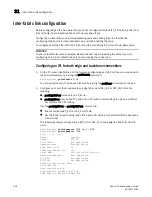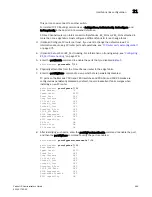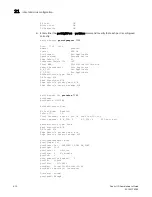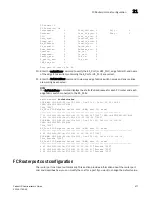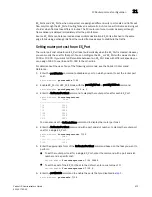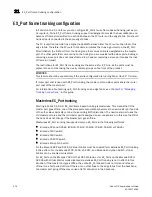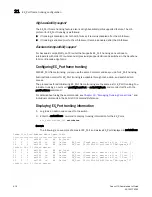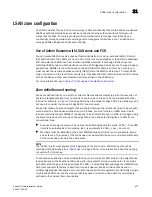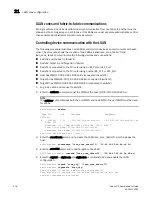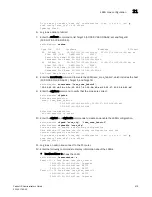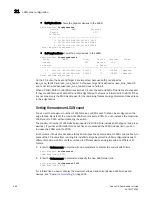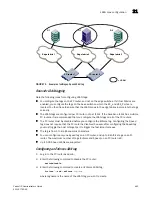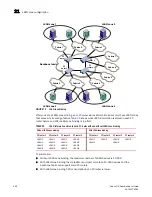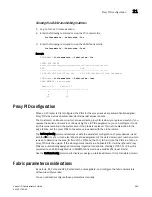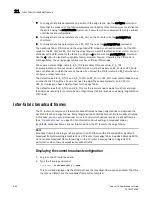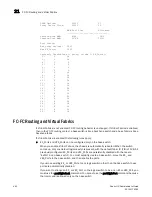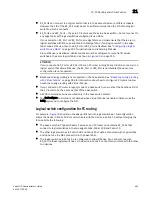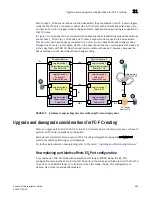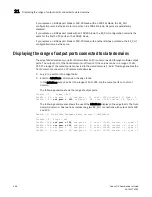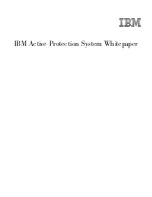
Fabric OS Administrator’s Guide
481
53-1001763-02
LSAN zone configuration
21
NOTE
Since the maximum number of LSANs is configured for each switch, if there is a different maximum
LSAN count on the switches throughout the metaSAN, then the device import/export will not be
identical on the FC routers. You should enter the same maximum LSAN count for all the FC routers
in the same backbone that support this feature. Verify the configured maximum limit against the
LSANs configured using the fcrResourceShow command.
Configuring backbone fabrics for interconnectivity
If you want devices in backbone fabrics to communicate with devices in edge fabrics, follow the
steps in the section
“Setting up LSAN zone binding”
on page 488. However, instead of configuring
the LSAN in the second edge fabric, configure the LSAN in the backbone fabric.
HA and downgrade considerations for LSAN zones
Be aware of how LSAN zones impact high availability and firmware downgrades:
•
The LSAN zone matrix is synchronized to the standby CP.
•
On a dual CP switch, both CPs must have Fabric OS v5.3.0 or later to enable the feature.
•
If the feature is enabled on the active CP, introducing a CP with an earlier version of Fabric OS
as a standby will cause HA synchronization to fail.
•
If the feature is enabled, before downgrading to an earlier Fabric OS version, you will be asked
to go back to the default mode.
•
This feature does not have any impact on current HA functionality. LSANs will be synchronized
as usual after the limit is increased and new LSANs are created.
LSAN zone policies using LSAN tagging
You can create tags for LSAN zones to give them a special meaning.
LSAN zones are zones with names that start with the “lsan_” prefix. You can specify a tag to
append to this prefix that causes the LSAN zone to be treated differently.
You can specify two types of tags:
•
Enforce tag – Specifies which LSANs are to be enforced in an FC router.
•
Speed tag – Specifies which LSANs are to be imported or exported faster than other LSANs.
The LSAN tags are persistently saved and support configupload and configdownload.
Enforce tag
The Enforce tag reduces the resources used in an FC router by limiting the number of LSAN zones
that will be enforced in that FC router.
Use the Enforce tag to achieve better scalability in the FC router. This is useful when multiple FC
routers are connected to the same edge fabric. Without the Enforce tag, all FC routers import all
LSAN zones, even those that are not needed.
Summary of Contents for 53-1001763-02
Page 1: ...53 1001763 02 13 September 2010 Fabric OS Administrator s Guide Supporting Fabric OS v6 4 0 ...
Page 4: ...iv Fabric OS Administrator s Guide 53 1001763 02 ...
Page 24: ...xxiv Fabric OS Administrator s Guide 53 1001763 02 ...
Page 28: ...xxviii Fabric OS Administrator s Guide 53 1001763 02 ...
Page 32: ...xxxii Fabric OS Administrator s Guide 53 1001763 02 ...
Page 40: ...xl Fabric OS Administrator s Guide 53 1001763 02 ...
Page 42: ...2 Fabric OS Administrator s Guide 53 1001763 02 ...
Page 54: ...14 Fabric OS Administrator s Guide 53 1001763 02 High availability of daemon processes 1 ...
Page 74: ...34 Fabric OS Administrator s Guide 53 1001763 02 Basic connections 2 ...
Page 102: ...62 Fabric OS Administrator s Guide 53 1001763 02 Audit log configuration 3 ...
Page 214: ...174 Fabric OS Administrator s Guide 53 1001763 02 Management interface security 7 ...
Page 228: ...188 Fabric OS Administrator s Guide 53 1001763 02 Brocade configuration form 8 ...
Page 276: ...236 Fabric OS Administrator s Guide 53 1001763 02 Creating a logical fabric using XISLs 10 ...
Page 404: ...364 Fabric OS Administrator s Guide 53 1001763 02 ...
Page 440: ...400 Fabric OS Administrator s Guide 53 1001763 02 Performance data collection 17 ...
Page 480: ...440 Fabric OS Administrator s Guide 53 1001763 02 F_Port masterless trunking 19 ...
Page 494: ...454 Fabric OS Administrator s Guide 53 1001763 02 Buffer credit recovery 20 ...
Page 574: ...534 Fabric OS Administrator s Guide 53 1001763 02 Hexadecimal overview E ...


